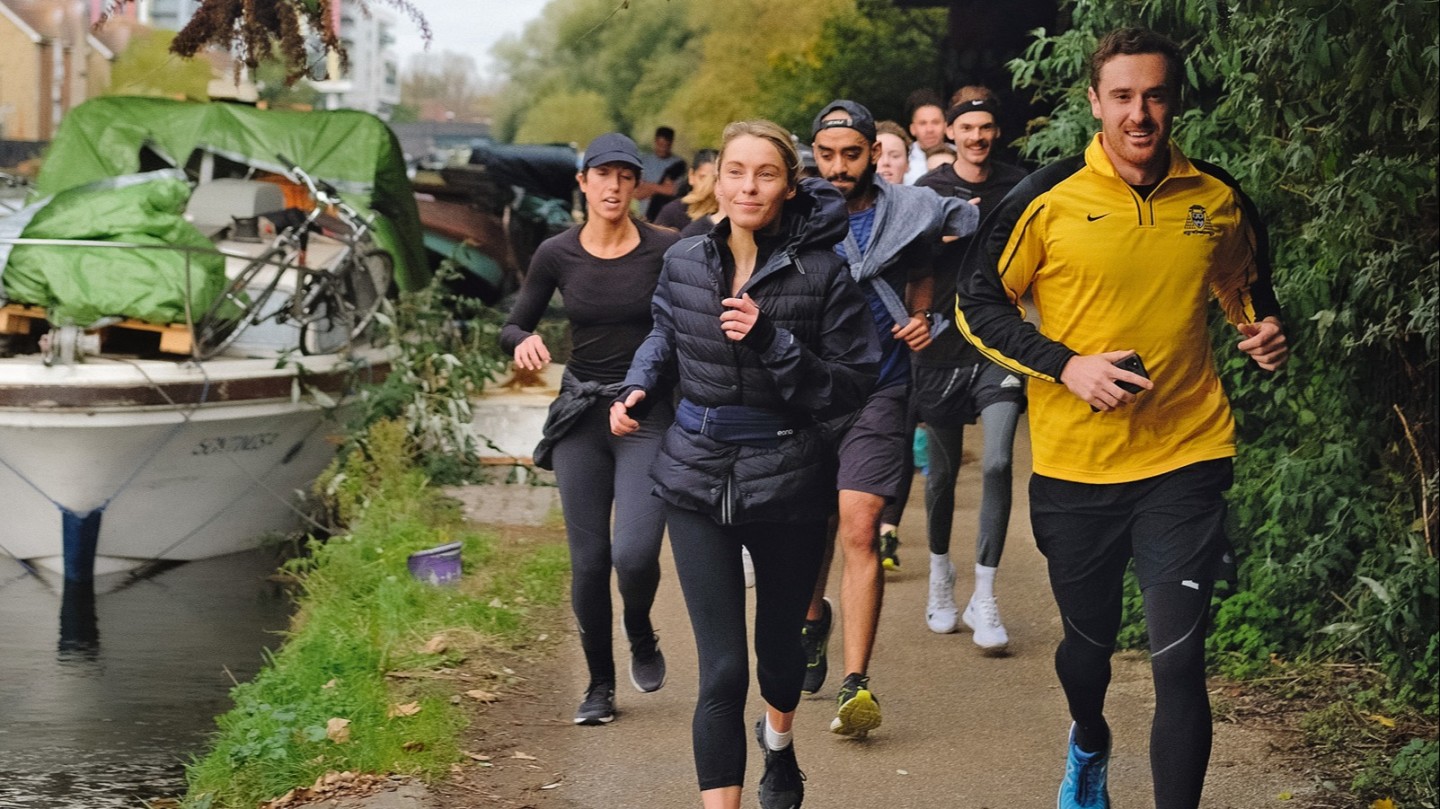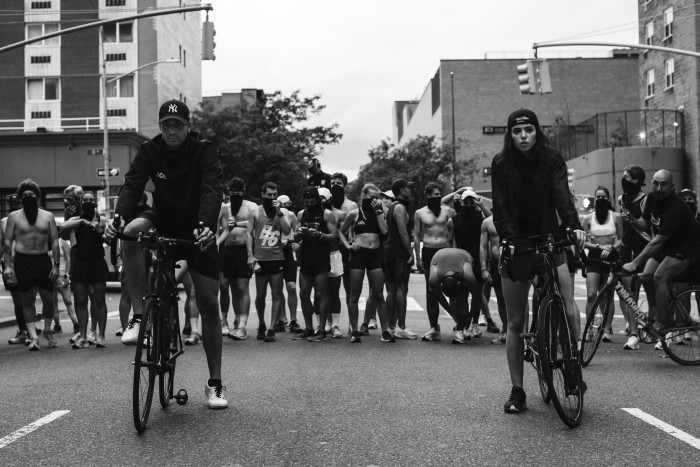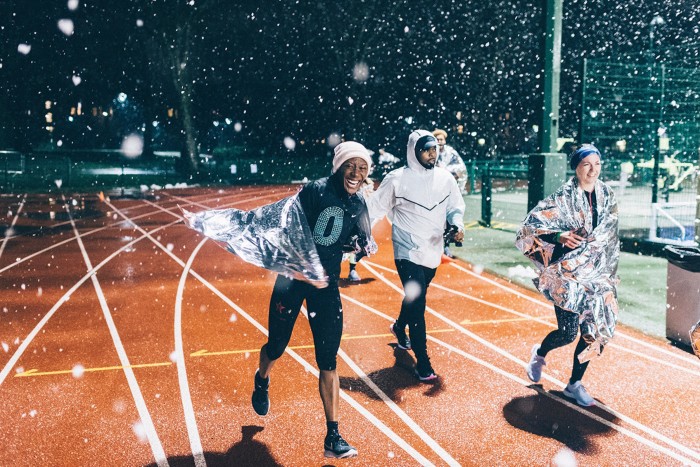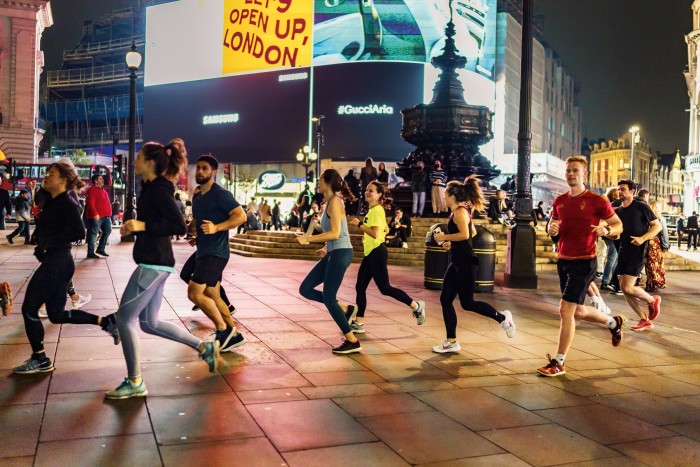The fast and the curious: the rise of the running club

Roula Khalaf, Editor of the FT, selects her favourite stories in this weekly newsletter.
It’s 9am on a winter Saturday in east London and the sky is blue, the air crisp. Gathered outside a Scandi-style café is a large crowd of young urbanites clad in caps and sports gear. Some sidle up to newcomers, inducting them into the fold with easy, early-morning chatter. More than 40 people stand in front of me – and every single one is embroiled in conversation.
This is the scene that begins my weekend, and has done since November, when I started making a 50-minute pilgrimage to jog 10km with Friendly Runners — a casual run club that has swiftly become my Saturday-morning mainstay. At 9.15am sharp, the clan divides into two groups — the “fast” and the “friendly” — with 80-plus sneaker-clad feet creating a rhythmic pounding as we weave our way past tower blocks and alongside the Regent’s Canal; eventually, we wind up back at the café and indulge in chat, coffees and pastries. “This is the reward for getting out of bed this early,” laughs Emma Lynas, clutching a jumbo-sized pain au chocolat. The 29-year-old head of account management in EU books at Amazon has been running with Friendly since September 2021.
Lynas and I are just two keen amateurs to have joined Friendly’s running ranks of late. In the past six months, the group — informally established three years ago by Oliver Hooson, a photographer, and Matt Horrocks, a marketing manager — has seen its numbers more than quadruple. “Every week it’s popping off,” says Hooson. “New people keep showing up. And they never come just once.”

Running club numbers are on an upward sprint. Washington DC’s Northeast Track Club, established in June 2020, started with around five runners; it now has nearly 200 attending each week. Kent AC, the south London hub of choice for 23-year-old Olympic silver medallist Alex Yee, has signed up more than a hundred members in the past year, while Orchard Street Runners — an intense club that sprints through Manhattan’s streets in the twilight hours – even has a waiting list. “Running collectively keeps you motivated, especially in winter,” says Sarah Mackenzie, chair of the 40-year-old Serpentine Running Club in London’s Hyde Park, which has signed up 182 new members since last June.
Running clubs offer a sense of on-demand community — a fundamental draw right now. Whatever the status of office life, flexi-working is likely here to stay. Many social touchpoints of daily interaction remain at a low. “We’ve been so isolated, and running is usually an isolating sport,” says Lee-Anne Zinetti, a Washington DC-based lung cancer-diagnostics strategist who joined NE Track Club last summer. “Clubs are a way to be around people, and we run at a conversational pace.” Abdulla Alhajri, a postdoctoral researcher, moved from Boston to London during the pandemic. He signed up to Friendly as a way to meet new people after discovering the club on Instagram.
Fun was a founding ethos for Friendly. The co-founders met after Hooson sold Horrocks a pair of Nike running shoes on Depop and they decided to run together; neither could find a club locally that was informal and “down to earth”, says Horrocks. (Traditional running clubs like Serpentine or Kent AC involve paid-for memberships, and the majority of members compete nationally.) Soon they invited some friends along — it has grown organically since. “The club is very much like the name itself,” says Horrocks. “It’s a running club for people who don’t consider themselves ‘runners’. It still feels like a community of friends just getting together for a jog.” That everyone stays for breakfast afterwards only feeds that feeling.

The growth of more amateur clubs chimes with the shift to social sports. When restaurants and gyms were shut, friends exercised together outdoors as a means of staying connected beyond the screen. Strava, the social network tracker for running and cycling, had 95 million active users in 2021, up from 73 million in 2020. They logged 2.4 billion miles in total – up 26.3 per cent on last year.
“Sport has become way more of a part of people’s everyday lifestyles,” says Dean Cook, head of menswear buying at Browns Fashion, who started an informal Browns running club that completes an after-work 7km route. During buying seasons in Milan, Paris and Tokyo, he takes it on tour — industry friends often join for the jog. “Before, it was all about social drinking, but I no longer want to wake up hungover and have a full day of meetings,” says Cook, who shepherded more than 30 keen runners — designers, photographers and buyers from rival stores — around Paris in September. He thinks alternative activities are a better way to forge relationships. “You get to know designers in a different way.” And as wellness becomes a way of life, some are quitting drinking altogether; Hooson says many of the runners at Friendly are “trying out teetotalism”. Lynas, the pastry lover, says the run club’s 9am start gives her “an excuse to have a quiet one on a Friday… I’m trying to maintain a better balance”.

In winter’s enveloping darkness, there’s a further benefit to running in groups. For women, it offers safety on the pavements. Dos Seis Uno (261), a women’s run club in Mexico City, fulfils that very aim. As does Orchard Street Runners, which hosts its weekly runs through Manhattan at night; here, social camaraderie is not the aim. The setup enables attendees to “run alone, together”, according to founder Joe DiNoto. In London, Thalia Renucci, a holistic health coach and campaign manager for apart-hotels, says, “My partner goes out running without his phone to properly switch off. I could never imagine doing that.” Through Friendly, she’s met other female runners she now jogs with before work.
While Friendly predominantly attracts millennials working in creative fields, some clubs offer the chance to expand one’s social horizons. At NE Track Club, Zinetti, who works for pharmaceutical company Novartis, runs with members of the Biden-Harris administration, as well as Gen-Z joggers who are big on social justice and the climate. “I meet people I’d never otherwise meet,” she says. Zinetti also runs with an elite marathon-runner, who attends the club for his “fun” runs. Recently, she got his tips on what to eat and drink before a 19-mile race. “Start hydrating two days before,” she says. “On the day, have an espresso, peanut butter and honey on toast and a banana, then a hydrogel an hour before the race. I had the best run ever. Even the last two miles weren’t hard.”
I’ll be bearing the Olympian’s nutritional advice in mind. Friendly has floated the idea of running a half marathon together in Paris this year. Until then, I’ll be chowing down on a cinnamon pastry from Pophams with my new-found jogging pals. Both of which are the spice of life.

Comments